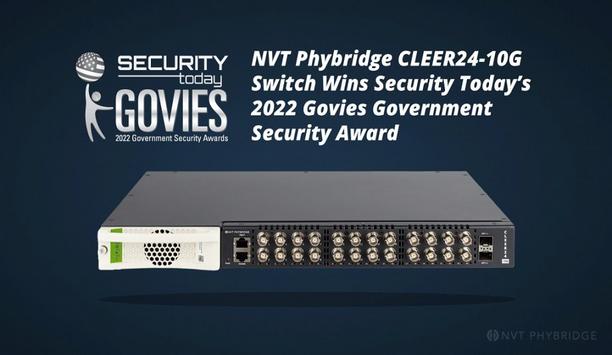NVT Phybridge - Experts & Thought Leaders
White papers from NVT Phybridge
Six ways to eliminate costs, risks and disruption to your network
DownloadLatest NVT Phybridge news & announcements
Hirotec, a well-known name in the automotive industry, provides automotive manufacturers with automotive closures, exhaust systems, and other manufacturing equipment. The organisation wanted to replace its outdated analogue surveillance system at its busiest manufacturing plant in Mexico to improve monitoring with high-quality images. Hirotec wanted IP cameras throughout the entire facility, with several locations well beyond the 330ft (100m) reach capability of standard switches. Concerned with the project’s potential complexity and business disruption, Hirotec needed an innovative solution to achieve its digital transformation objectives within its established budget and timelines. Digital transformation project Having used NVT Phybridge networking solutions in the past, Grupo SITE recommended the FLEX Power over Ethernet switch. The NVT Phybridge FLEX long-reach PoE switch delivers Ethernet and PoE++ over any new or existing multi-pair UTP infrastructure with up to 2,000ft (610m) reach, six times farther than standard switches. The reseller performed a thorough demonstration at the customer’s site. In just a few simple setup steps, the NVT Phybridge FLEX PoE switch delivered reliable power and data to IP cameras 2,000ft away, creating a secure and robust PoE backbone for the new IP surveillance system. Hirotec was impressed with the results and decided to move forward with the digital transformation project. Additional server closets NVT Phybridge long-reach PoE switches helped the customer accelerate its digital transformation Grupo SITE used NVT Phybridge long-reach PoE switches to enable IP cameras throughout the entire Hirotec manufacturing facility, without the cost of additional server closets or repeaters. Grupo SITE was able to accelerate the digital transformation project for the customer while significantly reducing business disruption and network downtime during deployment. “I thought that data and PoE over 90 meters would not be possible,” said Carlos Flores, IT Manager at Hirotec. “NVT Phybridge made it all possible! We now have a modern video surveillance system centralised in the MDF, which did not require an IDF in production!” NVT Phybridge long-reach PoE switches helped the customer accelerate its digital transformation while reducing total infrastructure costs by an estimated 50%. Existing network equipment The customer was extremely satisfied with the ease of ongoing management, compatibility with the existing network equipment, and performance of the FLEX switches. Hirotec now enjoys the benefits of IP surveillance, including improved monitoring and image quality. Grupo SITE used NVT Phybridge FLEX switches to achieve incredible results for the customer. Reduced deployment time by one-third. Eliminated business disruption by deploying on evenings and weekends. Reduced infrastructure costs by 50% by eliminating the need for additional server closets and repeaters. Gained the benefits of IP surveillance, including the real-time monitoring and recording of high-resolution video.
BASF, a pioneer in petrochemical manufacturing with multiple European sites, needed to upgrade its outdated analogue CCTV system at one of its massive German sites, housing over 2,000 buildings and 200 production sites. The customer wanted to deploy a TecTradeSolution IP surveillance solution to improve site monitoring and gain the ability to detect process anomalies throughout its production facilities and depots. Major crosstalk issues The company wanted to upgrade to IP surveillance but faced infrastructure challenges, as the old analogue solution was running on J-Y(ST)Y cabling. BASF needed a solution that could leverage its existing cabling to align with the organisation’s sustainability initiatives. An alternative PoE switch was used, which led to major crosstalk issues. This had to be replaced by a more robust network solution. BASF agreed to engage in a no-obligation proof-of-concept to test the technology in its environment The reseller partner, TecTradeSolution, was aware of NVT Phybridge long-reach PoE switches and proposed the use of FLEX8 PoE switches and FLEX adapters for the IP upgrade. The NVT Phybridge FLEX8 Power over Ethernet switch delivers Ethernet and PoE++ over any new or existing multi-pair UTP infrastructure with up to 2,000ft (610m) reach. BASF agreed to engage in a no-obligation proof-of-concept to test the technology in its environment. IP surveillance system After a few simple setup steps, the NVT Phybridge FLEX8 long reach PoE switch transformed the customer’s existing cabling infrastructure into a robust and secure network for the new IP surveillance system, while eliminating the crosstalk issues. BASF used the NVT Phybridge FLEX8 PoE switch to enable the new, high-resolution TecTradeSolution IP surveillance cameras for a seamless and highly secure deployment. The solution’s long-reach capabilities eliminated the need for additional IDF closets and solved the crosstalk issues the customer was initially facing while attempting to use an alternative solution. “Deployment using the NVT Phybridge FLEX8 switch was extremely easy, even at our longest distances,” said BASF. “There was no need for special training for the onsite assemblers and the product was quite literally a plug-and-play solution.” Detecting process anomalies TecTradeSolution was able to help the customer save both time and money TecTradeSolution was able to help the customer save both time and money while providing an innovative solution to solve the customer’s unique problems. The customer now enjoys the benefits of IP surveillance cameras, including improved monitoring, image quality, and the ability to detect process anomalies. BASF was extremely pleased with the results of the IP upgrade, having used the NVT Phybridge FLEX8 switch to: Eliminate crosstalk issues caused by a competitor’s networking. Use its existing network infrastructure to minimise operational disruption at the busy. Reduce infrastructure costs while significantly reducing project deployment. Create a highly secure and physically separate network for the new IP surveillance. Achieve its goals of sustainability by minimising cabling e-waste.
NVT Phybridge., a global pioneer in long-reach PoE solutions, announced that its CLEER24-10G switch was awarded a Platinum 2022 Govies Award from Security Today. Security Today is a security products magazine, e-newsletter, and website for security dealers, integrators, and end-users. The Govies Award, presented by Security Today and GovSec, recognises outstanding government security products in various categories, including features, innovation, user-friendliness, interoperability, quality, design, market opportunity, technical advances, scalability, and impact on the security industry. An independent panel of judges from the security industry selected the top entries. Power over Ethernet solutions I am proud of our teams to develop, market, and support Power over Ethernet solutions to public, and private sectors" “We are honoured to be a Platinum winner in the Network Support Solutions category for this year’s Govies,” said Richard Kasslack, Vice President of Sales and Corporate Development at NVT Phybridge. “I am extremely proud of the efforts of our teams to develop, market, and support industry-leading Power over Ethernet solutions to our public and private sector customers. This award is a testament to their hard work and dedication to excellence.” 1105 Media began the Security Today Govies award program in 2009. Competition for the award was greater than ever this year as concern for security in government continues to grow. CLEER24-10G Switch The NVT Phybridge CLEER24-10G Switch delivers up to 50 Watts of power (PoE++) and 10/100 Mbps symmetrical, full-duplex, over coax cabling with up to 6,000ft (1,830m) reach. Thousands of satisfied organisations and government agencies use NVT Phybridge Power over Ethernet solutions to simplify and improve digital transformation projects.
Insights & Opinions from thought leaders at NVT Phybridge
Once upon a time, providers had end-to-end control when deploying a physical security platform, which is not the case anymore when we consider the modernisation to IP. When considering the move to IP physical security, the provider needs to ensure the customer has a robust PoE backbone to connect the IP security device back to the application. Network readiness requirements have complicated IP security deployments, making it challenging for current providers while opening the door to new competitors. Competition is increasing Network providers see the move to IP as an opportunity to expand their wallet share. As the trusted advisors to IT teams, network providers leverage their position to win over the physical security business. As the time, cost, and complexity increases to move a customer to IP; providers need to expand their offering, considering the decline in endpoint revenue margins (the "race to the bottom"). Unfortunately, PoE networks are becoming increasingly complex as IoT endpoints are continually introduced to the network. Before the IP/IoT deployment can occur, the network provider (now your competition as well) will have the opportunity to edge you out and offer an IP/IoT solution with the network. The traditional approach is outdated They have standardised this cookie-cutter solution that may work for some, but not for all While we accept that we are collectively relying on our networks to support an increasing number of devices and applications, many have not considered the local area network's evolution. Organisations no longer only connect data terminals and printers to the network - they connect all manner of intelligent devices, including Wi-Fi access points, cameras, phones, access control, lighting, intercoms, and more. Many traditionalists will recommend the rip-and-replace of existing infrastructure while layering all IoT devices on the same network. They have standardised this cookie-cutter solution that may work for some, but not for all. What if there was a better way? Create the best outcome for you and your customer Let's start by thinking about the customer's desired outcome. The customer wants new capabilities within an acceptable ROI. Given the complications surrounding COVID-19, these organisations may require solutions very quickly to operate safely and within governmental guidelines. However, these organisations first need to establish a LAN framework without high costs, disruption to business, or complexity. They do not want to compromise network security or their business. They do not want network requirements to account for the majority of their budget as there is no ROI in infrastructure. The infrastructure supports the ROI gained from the devices and applications it enables. How do we provide a network solution that addresses both the customer and the provider's needs? Customers need a network that: Eliminates competitive pressures, giving providers end-to-end control over the network and the entire digital transformation experience. Shorten sales and deployment cycles to simplify network readiness and reduce the budget allocation towards infrastructure. Focus on device and application implementation and adoption to improve the customer's ROI. Build a physically separate PoE backbone for IP/IoT applications to maximise network security and performance while simplifying ongoing management. Eliminate the dependency on other providers. Advice from Albert Einstein We cannot solve a problem using the same kind of thinking we used when we created it" To help achieve these outcomes, I encourage you to accept some advice from Albert Einstein. Einstein once said, "The only thing that interferes with my learning is my education." Sometimes we are unwilling to accept new ideas because of preconceived notions about how things "ought to be done." We must embrace innovation and challenge our best practices that are based on past education. Einstein also said, "We cannot solve a problem using the same kind of thinking we used when we created it." Sometimes we must challenge ourselves to think differently by using innovations to create better outcomes for our businesses and customers. Consider this for a second: are you focused on the problem rather than finding a unique alternative solution? Einstein defined insanity as "doing the same thing over and over and expecting different results." Your customers are all unique with different digital transformation challenges and objectives. The cookie-cutter, rip-and-replace method has not worked for all. If it did, every organization would have all the IP and IoT solutions they need. It's time to consider a fresh new approach that may challenge your education. Don't let our education get in the way of your learning! Looking to innovation and modern solutions The idea of The Modern LAN, introduced by Frost & Sullivan, aims to present a paradigm shift in LAN design for IP and the IoT. The whitepaper, available for free using the link above, offers an enhancement to traditional LAN design to address IP and IoT devices' specific needs. Today, we connect more than just data terminals, and we must design our networks accordingly. Instead of starting with the network, Modern LAN design suggests starting with the endpoint requirements and building a network to address these considerations. One of the foundations of Modern LAN design is to consider all networking innovations available. NVT Phybridge PoE innovations allow you to leverage different cable types, including coax, single-pair UTP, and multi-pair UTP cabling, to enable IoT devices at much greater distances than traditional switches. Aligned with Modern LAN design, you can transform the existing network into a robust and secure PoE backbone instead of removing and replacing the reliable infrastructure. PoE switch solutions PoE switch solutions leverage different core technology that vary in capability and effectiveness I know what you may be thinking: Am I compromising on network performance by leveraging these innovations? The answer is: it depends on the technology. PoE switch solutions leverage different core technology (Homeplug, VDSL, ADSL, Ethernet, etc.) that vary in capability and effectiveness. For more than 15 years, NVT Phybridge has been a global pioneer in long-reach PoE technology. We were the first company to develop a switch that delivered Ethernet and PoE over a single pair of UTP wire with up to 1,200ft (365m) reach, which is four times the reach of standard switches. We have spent the last 15 years surprising the industry with our capabilities and satisfying customers with our technology. Performance is paramount We understand that innovation is met with scrutiny and skepticism. We also know that some companies make claims that they cannot back up, which can sometimes shed a negative light on an entire industry or product category. However, our enterprise-grade networking solutions have helped thousands of customers modernise to the next generation of intelligent devices without high costs, complexity, or disruption to their business. For example, our CLEER24 switch is a 24-port Ethernet over Coax innovation that delivers Ethernet and PoE+ over a single coax cable with up to 6,000ft (1,830m) reach, which is 18-times the reach of a standard switch. Transform network readiness requirements into an opportunity to grow your business! Be a thought leader, leverage Modern LAN design, and introduce NVT Phybridge PoE innovations to your customers. It's time to change the conversation around LAN design and improve the outcome for you and your customers.
Once upon a time, providers had end-to-end control when deploying a physical security platform, which is not the case anymore when we consider the modernisation to IP. When considering the move to IP physical security, the provider needs to ensure the customer has a robust PoE backbone to connect the IP security device back to the application. Network readiness requirements have complicated IP security deployments, making it challenging for current providers while opening the door to new competitors. Competition is increasing Network providers see the move to IP as an opportunity to expand their wallet share. As the trusted advisors to IT teams, network providers leverage their position to win over the physical security business. As the time, cost, and complexity increases to move a customer to IP; providers need to expand their offering, considering the decline in endpoint revenue margins (the "race to the bottom"). Unfortunately, PoE networks are becoming increasingly complex as IoT endpoints are continually introduced to the network. Before the IP/IoT deployment can occur, the network provider (now your competition as well) will have the opportunity to edge you out and offer an IP/IoT solution with the network. The traditional approach is outdated They have standardised this cookie-cutter solution that may work for some, but not for all While we accept that we are collectively relying on our networks to support an increasing number of devices and applications, many have not considered the local area network's evolution. Organisations no longer only connect data terminals and printers to the network - they connect all manner of intelligent devices, including Wi-Fi access points, cameras, phones, access control, lighting, intercoms, and more. Many traditionalists will recommend the rip-and-replace of existing infrastructure while layering all IoT devices on the same network. They have standardised this cookie-cutter solution that may work for some, but not for all. What if there was a better way? Create the best outcome for you and your customer Let's start by thinking about the customer's desired outcome. The customer wants new capabilities within an acceptable ROI. Given the complications surrounding COVID-19, these organisations may require solutions very quickly to operate safely and within governmental guidelines. However, these organisations first need to establish a LAN framework without high costs, disruption to business, or complexity. They do not want to compromise network security or their business. They do not want network requirements to account for the majority of their budget as there is no ROI in infrastructure. The infrastructure supports the ROI gained from the devices and applications it enables. How do we provide a network solution that addresses both the customer and the provider's needs? Customers need a network that: Eliminates competitive pressures, giving providers end-to-end control over the network and the entire digital transformation experience. Shorten sales and deployment cycles to simplify network readiness and reduce the budget allocation towards infrastructure. Focus on device and application implementation and adoption to improve the customer's ROI. Build a physically separate PoE backbone for IP/IoT applications to maximise network security and performance while simplifying ongoing management. Eliminate the dependency on other providers. Advice from Albert Einstein We cannot solve a problem using the same kind of thinking we used when we created it" To help achieve these outcomes, I encourage you to accept some advice from Albert Einstein. Einstein once said, "The only thing that interferes with my learning is my education." Sometimes we are unwilling to accept new ideas because of preconceived notions about how things "ought to be done." We must embrace innovation and challenge our best practices that are based on past education. Einstein also said, "We cannot solve a problem using the same kind of thinking we used when we created it." Sometimes we must challenge ourselves to think differently by using innovations to create better outcomes for our businesses and customers. Consider this for a second: are you focused on the problem rather than finding a unique alternative solution? Einstein defined insanity as "doing the same thing over and over and expecting different results." Your customers are all unique with different digital transformation challenges and objectives. The cookie-cutter, rip-and-replace method has not worked for all. If it did, every organization would have all the IP and IoT solutions they need. It's time to consider a fresh new approach that may challenge your education. Don't let our education get in the way of your learning! Looking to innovation and modern solutions The idea of The Modern LAN, introduced by Frost & Sullivan, aims to present a paradigm shift in LAN design for IP and the IoT. The whitepaper, available for free using the link above, offers an enhancement to traditional LAN design to address IP and IoT devices' specific needs. Today, we connect more than just data terminals, and we must design our networks accordingly. Instead of starting with the network, Modern LAN design suggests starting with the endpoint requirements and building a network to address these considerations. One of the foundations of Modern LAN design is to consider all networking innovations available. NVT Phybridge PoE innovations allow you to leverage different cable types, including coax, single-pair UTP, and multi-pair UTP cabling, to enable IoT devices at much greater distances than traditional switches. Aligned with Modern LAN design, you can transform the existing network into a robust and secure PoE backbone instead of removing and replacing the reliable infrastructure. PoE switch solutions PoE switch solutions leverage different core technology that vary in capability and effectiveness I know what you may be thinking: Am I compromising on network performance by leveraging these innovations? The answer is: it depends on the technology. PoE switch solutions leverage different core technology (Homeplug, VDSL, ADSL, Ethernet, etc.) that vary in capability and effectiveness. For more than 15 years, NVT Phybridge has been a global pioneer in long-reach PoE technology. We were the first company to develop a switch that delivered Ethernet and PoE over a single pair of UTP wire with up to 1,200ft (365m) reach, which is four times the reach of standard switches. We have spent the last 15 years surprising the industry with our capabilities and satisfying customers with our technology. Performance is paramount We understand that innovation is met with scrutiny and skepticism. We also know that some companies make claims that they cannot back up, which can sometimes shed a negative light on an entire industry or product category. However, our enterprise-grade networking solutions have helped thousands of customers modernise to the next generation of intelligent devices without high costs, complexity, or disruption to their business. For example, our CLEER24 switch is a 24-port Ethernet over Coax innovation that delivers Ethernet and PoE+ over a single coax cable with up to 6,000ft (1,830m) reach, which is 18-times the reach of a standard switch. Transform network readiness requirements into an opportunity to grow your business! Be a thought leader, leverage Modern LAN design, and introduce NVT Phybridge PoE innovations to your customers. It's time to change the conversation around LAN design and improve the outcome for you and your customers.
More good news for exhibitors on the second day of the Global Security Exchange (GSX) in Las Vegas. Brisk attendance continued early in the day, and then slowed somewhat in the afternoon, but most comments from exhibitors were positive. Exhibitors such as Lenel were “thrilled” with the show, and noticed the steady, good traffic and lots of sales leads. Lenel’s position at the front of the hall probably helped. New developments in mobile credentialing are a big trend at GSX, and Lenel’s BlueDiamond mobile credentials are traveling on a new path, so to speak. The access control company is introducing the idea of “Pathways” as a way of automatically signaling intent to a Bluetooth-enabled smart phone to open a door. A recognisable “pathway” is programmed into the phone, based on signals from nearby readers and locks and also geolocation signals. The system recognises when a user travels along the pathway and automatically signals the correct door(s) to be opened along the way without the user having to touch his smart phone.A recognisable “pathway” is programmed into the phone, based on signals from nearby readers, locks and also geolocation signals Providing a lightweight alternative “When you trigger a pathway, it’s signalling intent to open the door,” says Greg Berry, Vice President Mobile Credentialing, Global Security Products, for United Technologies, parent company of Lenel. “Pathways are customised to a user’s needs and are the common places you are going all the time.” A user who walks the same path daily to the door of an office will find that door opens automatically. Previously using mobile credentials has been “slightly more work than using a badge,” says David Weinbach, Manager of Identity and Product Innovation for Lenel. “Now with Pathways, it’s less work than using a badge.” Specifically, a user no longer has to take out his phone and push a button to signal intent. “Rather than trying to emulate the badge, you create an experience that is better than the badge,” adds Berry. “We want to change the paradigm and turn the market on its ear.”New browser-based clients are being released with each new version of OnGuard software Other news from Lenel includes the release of more mobile and browser-based clients for OnGuard to be used for greater convenience alongside the Window-based clients. Providing a “lightweight” alternative enables some of the functionality of the Windows client in a format that is easy to access on the go. New browser-based clients are being released with each new version of OnGuard software. Cloud-hosted systems using Microsoft Azure are also among the plans for OnGuard, which ultimately will offer on-premises and cloud options. There’s not much comment from the Lenel folks about their parent company United Technologies’ plan to acquire S2 Security, which was announced days before the show. They would only say that the acquisition is waiting for regulatory approval, and that the expectation is that the two companies’ products will be complementary, given S2’s focus on the SMB (small and medium-sized business) market and Lenel’s strength at the enterprise level. The acquisition strategy is to grow both businesses. More details to come about the new combined company. Modern network infrastructure NVT Phybridge, a PoE connections company located near the back of the hall, also reported steady booth traffic on Day 2. “There are lots of customers and partners here,” said Steven Fair, Executive Vice President. “We are pleased with the quality of people, but not overwhelmed with the quantity.” FacePRO AI facial recognition is used for real-time searches of terror suspects or criminals throughout a location NVT Phybridge, which provides IP networking products for the telephony industry as well as security, is focused on networking concepts at GSX, in particular the changing requirements for network infrastructure in the age of IoT. We are pleased with the quality of people, but not overwhelmed with the quantity.” Fair uses the term “Modern LAN” to describe the new, changing requirements and in consideration of the specific networking needs of each edge device, whether cameras, sensors, or door access control devices. “Start with the edge device — what does it need from the network? What are its needs and have there been any innovations to enable you to connect to the network more economically?” asks Fair. There is also a green aspect to designing network infrastructure. Can existing equipment, such as coaxial or single twisted-pair cabling, be used, and thus save on disposal costs of the used cabling as well as lowering installation costs? Among NVT Phybridge’s offerings that can serve the changing networking needs in the IoT era is Smart Path PoE, which offers smart power, smart network access and secure connections. The CLEER family of products provides ethernet over existing coaxial cabling to enable easy transition from analogue to IP cameras. The PoLRE products supply ethernet and power to travel over a single unshielded twisted pair cable with reach over 400 metres. The products have been used recently to transition a series of cruise ships from analogue to IP video without having to replace cabling and spending only two days in dry dock for the installs. A new focus away from AI Panasonic is looking to apply AI-based capabilities to vehicle recognition in the near future, with the ability to identify vehicle characteristics Deep learning and artificial intelligence (AI) seem to be taking a lower profile at this show, perhaps signaling the end of the hype. Companies that mention AI point to specific products that use the technology and are currently available. For example, Panasonic is featuring its FacePRO AI-based facial recognition system. The system uses face images captured from video — grabbing up to 30 to 35 faces a second as video is recorded. The system saves the best of those face images, eliminating extensive duplication, as thumbnails, which are linked to the video footage where the faces appear. To find video in which a face appears, the operator merely drags-and-drops the thumbnail image and commands the system to “go fetch” video that contains that face. The system then produces a timeline showing where the face appears in the feed from each video camera on the premises, so an operator can track the movements of a suspect throughout a facility. The tool helps to simplify and shorten the workflow of locating a suspect in real-time and is affordable for a wider range of uses beyond the traditional airports or high-end applications. The FacePRO software is offered on any Panasonic camera, and works with a separate FacePRO server that is integrated with the video recorder. The system can be added easily to existing systems and is useful for such applications as real-time searches for terror suspects or other criminals throughout a location. Panasonic is also looking to apply AI-based capabilities to vehicle recognition, too, in the near future, with the ability to identify vehicle characteristics such as color, type of vehicle and direction of travel. On the VMS side, Panasonic is transitioning its Video Insight software to a modular approach, tailoring solutions for a growing range of vertical markets, such as transportation and retail, all using “plug-ins” that enhance operation of Video Insight software. No additional license fees are involved That’s just a sampling of what I saw on Day 2 of the show. I have more to share in a final show report, including what I see tomorrow on the final (shortened) day.
Using artificial intelligence (AI) to automate physical security systems
DownloadA modern guide to data loss prevention
Download7 proven solutions for law enforcement key control and asset management
DownloadThe truth behind 9 mobile access myths
DownloadAccess control system planning phase 2
DownloadNVT Phybridge NV-EC-04 EC4 Adapter
NVT Phybridge NV-ECLK EC-Link Adapter
NVT Phybridge NV-ECLK-PLS EC-Link+ Adapter





















